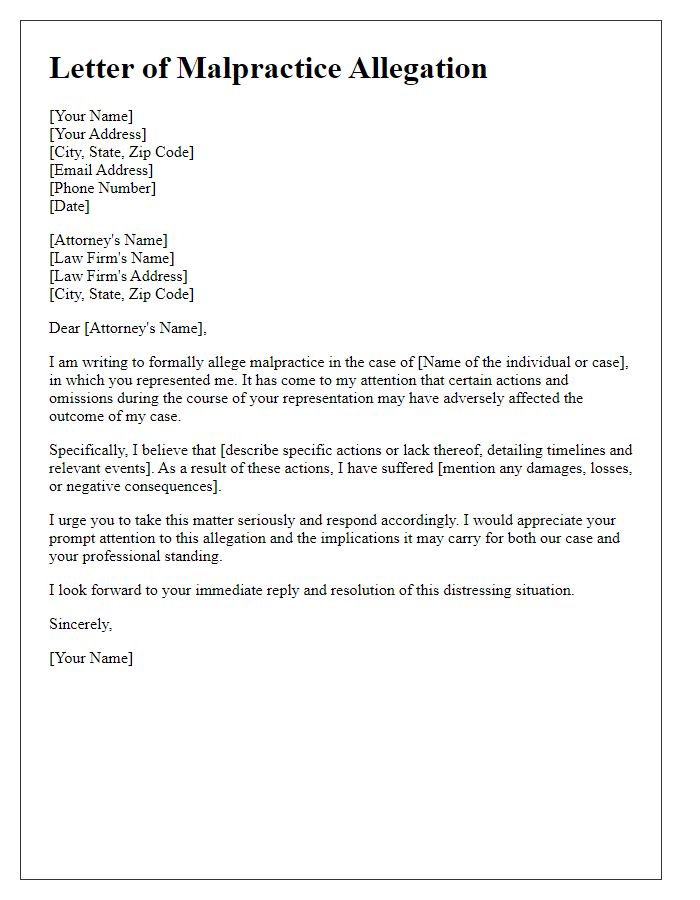Navigating the waters of legal malpractice can feel overwhelming, but it's crucial to understand your rights and options. Every attorney has a duty to provide competent representation, and when that duty is breached, clients may suffer significant consequences. If you believe you've experienced legal malpractice, this letter template can help you communicate your claims effectively. Ready to learn more about how to protect yourself and initiate a claim?

Clear identification of the attorney and law firm involved.
In a legal malpractice claim, clear identification of the attorney and the law firm involved is essential for establishing accountability and facilitating the resolution process. The attorney's full name, including middle initials if applicable, must be prominently stated, alongside their official title, such as Partner or Associate. Additionally, the law firm's complete name, along with its address, should be included to provide a formal context. This ensures that all parties involved, including insurance carriers and regulatory bodies, can accurately recognize and address the specific individuals and entities implicated in the claim. Furthermore, including any relevant identification numbers, such as bar license numbers or firm registration details, can further enhance the clarity and traceability of the claim, supporting effective communication and action moving forward.
Detailed description of the alleged malpractice incident.
In September 2022, during a critical phase of my civil litigation case (Case No. 12345), my former attorney, John Smith, failed to file essential documents by the court-imposed deadline in the Superior Court of California, Los Angeles County. This lapse led to the dismissal of my case, severely undermining my legal standing and resulting in significant financial losses. Specifically, the attorney neglected to submit a motion for summary judgment, which was crucial for our argument against the opposing party's (XYZ Corporation) claims. The missed deadline occurred despite multiple reminders and a clear agreement outlining the timeline of submissions. As a result, my right to pursue further legal recourse was compromised, causing emotional distress and additional costs exceeding $50,000 that included filing fees and attorney's fees for subsequent legal counsel needed to address the fallout. This incident represents a clear deviation from the standard of care expected of an attorney, constituting professional negligence.
Description of damages or harm suffered due to the malpractice.
Legal malpractice claims can arise from inadequate representation by an attorney in various settings. Victims may suffer financial losses, such as lost settlements or judgments, resulting from the attorney's negligence in handling a personal injury case, which can amount to thousands of dollars. Emotional distress is another significant harm, frequently caused by prolonged legal battles that could have been settled more efficiently. There may also be reputational damage, particularly if a lawyer mishandles a criminal defense case, potentially leading to wrongful convictions. The statute of limitations for filing such claims typically ranges from one to three years, prompting swift action by those affected. Documentation of damages, including bills from legal fees or medical expenses, is crucial in substantiating the effects of the attorney's malpractice on the client's life.
Reference to relevant legal and ethical standards breached.
Legal malpractice claims often arise from attorneys failing to meet the established legal and ethical standards set by the American Bar Association (ABA) and state bar associations. Breaches may include neglecting to file important documents within statutory deadlines, violating client confidentiality, or lacking adequate communication regarding case progress. For instance, a failure to adhere to the Model Rules of Professional Conduct, particularly Rule 1.3 (diligence) and Rule 1.4 (communication), can significantly harm client cases. Instances of negligence, such as missing a court date resulting in default judgment, greatly affect the outcome and warrant a claim. Understanding these breaches is crucial for identifying grounds in a legal malpractice case.
Demand for resolution or remediation action.
Legal malpractice claims arise from instances when an attorney fails to perform competently or violates ethical standards. Clients may demand resolution regarding negligent actions that led to financial loss or adverse legal outcomes. Evidence presented in such claims often includes details about the attorney's failure to meet deadlines, incorrectly applied laws, or insufficient legal representation during critical cases. Cases may involve complex litigation in jurisdictions such as California or New York, where specific statutes define malpractice criteria. Additionally, documentation of previous communications, invoices, and retainer agreements can bolster the claim. Seeking resolution often requires remediating actions like monetary compensation or restitution for lost opportunities due to the attorney's ineffectiveness.













Comments